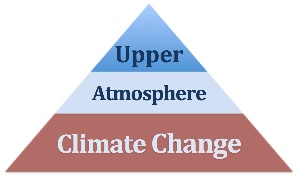Versions Compared
Key
- This line was added.
- This line was removed.
- Formatting was changed.
 Image Added
Image Added
 Image Added
Image Added
Project Summary
| Section | |||||||||||||||
|---|---|---|---|---|---|---|---|---|---|---|---|---|---|---|---|
| |||||||||||||||
Schedule
| |||||||||||||||
| |||||||||||||||
Meeting and Agenda |
| Section | ||
|---|---|---|
| ||
Publication |
| Section | ||
|---|---|---|
| ||
Final Report |
| Section | ||
|---|---|---|
| ||
For Team Members |
for further information and collaboration, please contact
Shunrong Zhang ♦ MIT Haystack Observatory ♦ shunrong ((at)) mit dot edu. ◊ or any of the team members
Climate change is characterized by global surface warming associated with the anthropogenic increase in greenhouse gas concentrations since the start of the industrial era. In the Earth’s upper atmosphere where many modern technologies reside, it is now recognized that a long-term cooling has been taking place over the past several solar cycles. Compelling evidence for such cooling comes from direct measurements of the thermospheric density and the ionospheric temperature. A lot more indirect evidence has become available since the 1990s following a seminal modeling study by Roble and Dickinson (1989), suggesting potential effects of increased greenhouse gases on the ionosphere and thermosphere. However, there are several outstanding issues, for example, (1) the very strong ionospheric cooling observed by multiple ionospheric radars that does not fit with the prevailing theory based on the argument of anthropogenic greenhouse gas increases; (2) CO2 trends in the mesopause region observed by satellite missions are about twice of what current general circulation models predict; (3) trends in atmospheric wave activity and their impacts on the atmosphere-ionosphere system are poorly known and unquantified. Our international team will be taking on these challenging outstanding topics as our research theme, with the goal to improve the understanding of the long-term trends in the ionosphere and thermosphere.
Three main research focuses are (1
The increase in anthropogenic greenhouse gases and the associated global change are well recognized problems. As space physicists, we ask two essential questions: Does the greenhouse gas increase affect the upper atmosphere directly, including neutral species and charged particles? Does the surface global change contribute indirectly to the upper atmospheric long-term change? Roble and Dickinson [1989] indicated using a General Circulation Model (GCM) simulation that doubling the CO2 concentration in the thermosphere will cause ~50ºK increase in the thermospheric (exospheric) temperature as well as 50% reduction in neutral densities near 200-300 km, as a result of atmospheric contraction, the “falling sky”. The ionosphere, embedded in the dense neutral atmosphere environment, is expected to experience changes in plasma density and its height distribution.
Detecting long-term changes in the upper atmosphere has been an area of active research following the Roble and Dickinson [1989] study. Ionosonde-based trend detection provided initial evidence of the ionospheric cooling [e.g., Ulich and Turunen, 1997, and as summarized in Laštovička, et al., 2006]. Further compelling evidence of long-term upper atmospheric cooling has come from carefully calibrated datasets of the thermosphere and the ionosphere thermal status, including satellite drag data [e.g., Keating et al., 2000; Emmert et al., 2004, Marcos et al., 2005], which are strongly determined by neutral density, and incoherent scatter radar (ISR) ion temperature data [Holt and Zhang, 2008; Zhang et al., 2013; Ogawa et al., 2015], which are strongly correlated with neutral temperature.
This project provides a new opportunity to review those existing observational and modeling results, and examine all possible causes for the long-term trends in the ionosphere and thermosphere. Specially, our project will focus on the following scientific topics that address the aforementioned outstanding and challenging questions.
1. Greenhouse gas increase and long-term trends. Thermosphere-ionosphere GCM modeling studies [Qian et al., 2006; Solomon et al., 2015] suggest that the observed long-term change in thermospheric density is mainly caused by the increase of CO2 which act as an efficient cooling agent in the thermosphere. CO2 is increasing throughout the atmosphere, but the recent satellite measurements of CO2 showed that it is increasing faster above the mesopause than in the lower and middle atmosphere [Emmert et al., 2012; Yue et al., 2015]. This presents a challenge to understand thermospheric trends. Therefore a revisit to the greenhouse gas effect with recent observations and the state-of-the art modeling is highly needed.We propose to form an international team to work on these important aspects of the upper atmospheric long-term change. Three specific research tasks are: (a) characterizing long-term trends with observations from in-situ and ground-based remote sensing instruments . This will be conducted by summarizing and reviewing all existing ionospheric and thermospheric trend results; (b2) understanding the various driving mechanisms and identifying the ones those that can consistently account for key observations; (c3) evaluating potential the societal impacts of climate changes in the upper atmosphere. The research task focus area (b2) is the central area center of our effort for which we . We plan to examine drivers from below and above, specifically,, including (i) greenhouse gas effects with more accurate CO2 observational data and state-of-the-art models, (ii) potential lower atmosphere wave activity effects originating from global climate change, (iii) impact of secular changes of solar and magnetic activity, and (iv) effects of secular Earth magnetic field changes.
The outcome from this coordinated research effort includes publications and papers that provide comprehensive reviews of the long-term change pattern in the upper atmosphere, and highlight significantly improved understanding of the relative roles of major contributing factors to the observed trends. In particular, we anticipate new insights and will strive to reasonable scientific consensus regarding some important observational puzzles leading to new discoveries.
The team consists of scientists from 7 different countries actively working in the area of upper atmospheric climate change from various perspectives, covering satellite and ground-based observations from the lower to upper atmosphere, modeling and simulation, and ionosphere-thermosphere coupling.
The team members will meet for 2 one-week meetings, the May 2017 meeting at ISSI and the May 2018 meeting at ISSI-BJ.